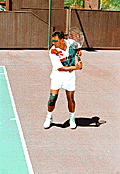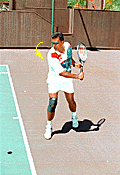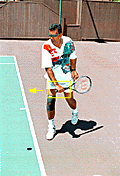|
TennisOne Lessons
Shot Selection in the Neutral Mode
|
  |
Baseline Backhand
In the neutral mode on the baseline, you want to hit the ball squarely,
move your opponent, and hopefully try to create an opening with a sequence
of shots rather than just an outright winner. This is a patient strategy
where you're careful to avoid errors and at the same time hitting out enough
to avoid being attacked. So the topspin drive is a good choice in this situation,
not a full-blooded winner, but rather a strong drive that keeps your opponent
from an offensive position.
In the first photo below, you can see our pro, Nigel O'Rourke, is preparing
early, his weight is back, his elbows and knees both lightly flexed,and
the racquet head is up at the top of the loop. As you work through the TennisONE
library you will find constant references to the benefits of the looping
swing with this type of backswing. One of the many advantages is the
disguise that accrues from this high start. From this position,
Nigel could just as easily drop down heavily against the ball from this
position to create the underspin drive, or loop lower and swing up for topspin,
both shots from the same start. Additionally, were he just a few steps closer
inside the baseline, this same high start could produce a nifty drop shot.
  |
But back to the backhand drive. In the second photo, Nigel begins to drop
the racquet as he coils his shoulders and starts to shift my weight forward.
Elbows and knees are still flexed, and both hands are still on the racquet.
In the first photo below, you see the "butt cap" of Nigel's racquet at the bottom of the swing pointing exactly at the ball. This gives him great leverage to pull the racquet through the ball. The finish shows the classic splitting of the hands. His racquet has moved up through the ball, and his concentration and balance are classic. He has driven the ball cleanly and will now be ready to look for a weak reply so he can move from the neutral to an offensive mode.